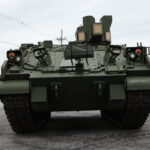
Textron [TXT and its team of Howe & Howe and FLIR [FLIR] is set to deliver the first Ripsaw M5 robotic vehicles for the Army’s Robotic Combat Vehicle-Medium (RCV-M) prototype program before the end of the year, as well as recently receiving an additional deal to deliver an all-electric variant. Officials told reporters on Thursday the companies have been driving the purpose-built Ripsaw M5 almost daily in preparation for initial deliveries, gathering hundreds of test hours on the platform. “We’ve…

 By
By 











